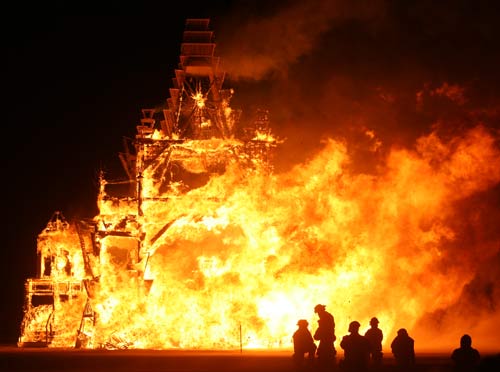Open fire projects can be as large as the Temple, or as small and intimate as a fiery urn on the open playa. Fire can be a great way to bring folks together on a chilly playa night, or to send your artwork to the spirits in a final fiery conflagration. Whatever the size, all fire platforms and containers need to be six inches off the ground.
Open Fire Definitions
Open fire (OF) is defined as simple burning of solid or unpressurized liquid fuels, without any enhancement by mechanical devices, extra oxidizers or pyrotechnic materials.
Burning Man defines three different types or levels of open fire, each with different characteristics, and each requiring different approval processes and safety procedures.
Open Fire Level One (OF-1): Structure on Decomposed Granite on Playa
For the burning of a structure on decomposed granite (DG) on playa. Examples include:
- Any sculpture burning in close proximity to the playa surface
- Any artwork fully engulfed in flames producing a tremendous amount of heat
- The Man, the Temple, and any art project approved to burn
Requirements for OF-1:
- Close communication with the Fire Art Safety Team (FAST)
- A burn laminate
- A 4″ deep burn shield (decomposed granite aka DG) to prevent burn scars on the playa surface
- Safety perimeter
- Fire extinguishers
- Ranger and/or Emergency Services Dept. support (artwork dependent)
Open Fire Level Two (OF-2): Enclosed Container Fire
For fire in an enclosed container. OF-2 refers to the simple burning of unpressurized fuel within fireproof containment. Examples include:
- Burn barrels
- Braziers or other raised containers
- Oil lamps
- Torches
- Candles
- Other simple uses of fire
Requirements for OF-2:
- Safety perimeter
- Fire extinguishers
- Fire must be within appropriate fireproof container and away from playa surface
- Precautions must be taken to ensure that anything that should not be set on fire (fabric, stage sets, etc.) is kept away from flame
As long as all fire, fuel, embers, etc. are kept contained and away from the playa surface, neither a burn shield nor a burn laminate are required for this level.
Open Fire Level Three (OF-3): Relocatable Art to Burn
OF-3 is for relocatable art to burn. It is artwork created/staged in one location that is moved for burning at an approved burn shield platform such as one of the Community Burn Gardens located at 3:00, 6:00 and 9:00 along the Esplanade, which are open from 10am Sunday after the Man burn through Tuesday post-event.
Requirements for OF-3:
ONLY wood may be burned in the Burn Gardens:
- NO PARTICLE BOARD OR PAINTED WOOD
- NO liquid fuel
- NO cardboard, paper, compost, recycling, trash, or toxic materials such as carpets, cushioned furniture, PVC and other plastics (burning of toxic/synthetics is prohibited by law)
- Practice good safety! Be aware of your situation (Burn Gardens are tall)
- All wood must be burned in the Burn Garden container, NOT ON THE PLAYA
Safety Guidelines for Open Fire Level One (OF1)
Burn Shield
A burn shield separates and insulates the playa from burn scarring (baking and discoloration) caused by the intense heat of an open fire burn. Decomposed granite (DG) is the material we use for protecting the playa.
We have found that a layer of DG placed on the surface of the playa prior to construction of the artwork is the simplest and most effective burn shield. All art projects that are burning must have a 4-inch thick layer of DG between the art and the playa surface. When spreading a DG layer, care must be taken not to leave any exposed areas, and to prevent the DG from being displaced by participants.
Arrangements for the purchase of DG are made through Art Support Services (ASS) after the initial burn meeting between your project team and the FAST Artist Liaison. In addition to the purchase price, a pre-event deposit will be required to insure that the DG you use is thoroughly cleaned by your Leave No Trace (LNT) team prior to removal the morning after your burn.
You can read more about Burn Shields on our Burn Scar Prevention page.
Artwork Materials and Construction
Materials NOT to Burn
Toxic Materials:
Avoid incorporating plastics and synthetics into your artwork. The burning of any toxic materials in your artwork is prohibited by law.
Materials NOT to be burned due to toxic materials:
- Furniture
- Paint
- Rugs
- Many other objects typically used to decorate artworks. Talk to your artist liaison or FAST representative if you have any questions about what is acceptable.
All such items MUST be removed from your artwork before it is burned.
Materials That Create Airborne Embers:
Over the years we have found a short list of materials that, when burned, create excessive embers and floating burning materials. These loose sources of unintended ignition can cause issues for mutant vehicles at the burn perimeter, nearby art projects, and participants at the burn. Discuss all materials with the FAST OF Manager pre-event.
Materials NOT to be burned due to embers include:
- Fabric
- Paint
- Cardboard
- Large sections of papier-mâché
- Thin wood laminates or pressboard
- Plywood less than 5/8th inches thick
- OSB, chipboard, and particle-board
Engineered and Glue Laminated Structural Elements
Although your burn day and time will be decided pre-event, please confirm that day and time with FAST after checking in at the ARTery. While FAST will try to accommodate your preferred burn time, it can not be guaranteed, and it may be changed due to weather, emergencies, or other unforeseen circumstances.
Your Fire Safety Liaison is responsible for maintaining daily contact with FAST to stay apprised of any schedule adjustments or other advisories. Relevant information will be passed along to the artist.
Scheduled Burn Time
Although your burn day and time will be decided pre-event during your burn meeting, please confirm that day and time with FAST after checking in at the ARTery. While FAST will try to accommodate your preferred burn time, it can not be guaranteed, and it may be changed due to weather, emergencies, or other unforeseen circumstances.
Your FAST Artist Liaison is responsible for maintaining daily contact with FAST to stay apprised of any schedule adjustments or other advisories. Relevant information will be passed along to the artist.
FAST Lead Coordination Before Burning
At least one hour before your scheduled burn time (or earlier, depending on the complexity of your burn) a member of FAST designated as the FAST Lead (the person supervising your burn) will arrive at your installation at the 9 o’clock position of your burn to identify themselves to the artists to coordinate with the project team, which includes the artist and all fire leads.
Your perimeter must be set and solid before FAST arrives or it could result in a delay or cancellation of your burn.
Do not add fuel to the artwork before FAST arrives. The FAST Lead will make a final check of your piece, and if all is in order, they will issue a burn laminate for your piece, and inform the Black Rock Rangers and the Emergency Services Department (ESD) that it is on schedule to burn. When you are given the green light, you will be informed to fuel your piece and complete your preparations to burn. A FAST member will also check the weather.
You can and should be making other preparations prior to that time, however, and continue making them after the FAST Lead arrives.
The FAST Lead is a knowledgeable resource who can help you troubleshoot last-minute problems with your preparations. If in doubt about anything, don’t guess: make use of the FAST Lead’s expertise.
The FAST Lead has final say over when you are allowed to:
- Apply accelerants
- Start your performance and/or pyrotechnics show, if any
- Ignite the artwork
- Release the safety perimeter
Establishing the Safety Perimeter
Your burn’s safety perimeter keeps participants from straying into areas where they could be injured or interfere with the work of your crew. Designing and managing a burn’s perimeter is one of the most complex aspects of the entire burn, with many factors to consider. Read more about Managing a Burn Perimeter here.
Plan to establish a smaller perimeter several hours ahead of burn time to allow for preparation of the structure, loading of pyrotechnics, etc. Create a perimeter before prepping for the burn. At that point, participants are no longer allowed on the site for safety.
Preparing the Structure
Once the perimeter is set and there is no danger of participants entering the work area, the preparations can begin, including:
- Clearing structure contents
- Cordwood loading
- Structural hobbling
- Pyro loading
All pyrotechnic material must be listed and approved pre-event. An inspection of its placement will be required on-site at the discretion of FAST. Any questions please contact the Pyrotechnics team at pyro@burningman.org.
Final Checks and Approval
When all the above preparations are complete, the FAST Lead, Burn Lead, and Pyrotechnic Operator (if needed) will make a final check of the artwork, looking for any stowaways or stragglers, and for any hazardous conditions that may have developed while preparations were underway.
If liquid accelerants are needed, a fueling team applies them at this time after being given the clear by the FAST Lead on site, using methods documented in the burn plan and approved by FAST at the pre-event meeting. A member of your burn team must follow a fueler with a fully-charged fire extinguisher — and also be trained in its use — while accelerants are being applied. Each fueler must be followed by someone with an extinguisher.
After a final check and fueling of the structure, the “No-Man’s Land” zone of the burn circle is closed to further entry until the artwork is ignited and the structure has fallen.
Just before ignition, the FAST Lead checks the weather. Barring any high wind conditions or other negative weather factors, you will receive an OK to burn from the FAST Lead. The FAST Lead issues the necessary burn laminate(s), and informs the Black Rock Rangers and ESD that the artwork is ready to burn.
Ignition
At this time, the final sequence of the burn, pyrotechnics, and any ignition ritual can begin.
All of these elements of the burn must be conducted in a way that prevents premature ignition, to ensure the safety of the fuel team while they are in or near the fueled structure.
Important Note: No one on the fuel team should be tasked with the actual ignition of the structure, as there is a chance they will have fuel on their clothing.
Hazard Mitigation
FAST will make the decision to drop the perimeter when all conditions are determined safe, based on conversations with ESD. For all burns the decision on when to drop the perimeter is based on a variety of determinants, such as when the highest pieces of the artwork have fallen. The idea is that a hazardous situation exists until all components of the artwork over seven feet tall that may conceivably fall have actually fallen and no pieces of art are off the DG.
Any unburned materials that have fallen beyond the burn shield must be thrown or pushed back into the fire. Further, these items must not become tripping hazards for participants approaching the fire once the perimeter is dropped.
If any rebar, ground screws/ground anchors or stakes are protruding above the playa surface that cannot be removed before the perimeter comes down, cones must be placed over them to alert participants.
Following structure collapse, for projects involving pyrotechnics, FAST will NOT allow anyone to go INTO a structure, but if they are in appropriate safety gear (i.e., firefighter turnout gear) they will be permitted to do a sweep around the perimeter of the structure for any large fuel mortars, or unspent pyrotechnics. They should be accompanied by an also well-geared-up member of FAST (preferably from the Pyro team). Fuel mortars should be tipped toward the burning structure, and pyro should be either removed if it is safe to do so, or placed into the fire. All materials must be neutralized before the perimeter is dropped.
Only then should the perimeter be released.
Releasing the Perimeter
The perimeter can be released after:
- All hazard mitigations listed above have been completed to the satisfaction of the FAST Lead.
- No part of the artwork stands more than 7 feet higher than the playa.
- Once FAST gives the ok then Rangers, Burn Perimeter Safety (BPS) and/or a combination of these will work with the Perimeter Leads to release the perimeter at the same time for safety.
Burn Aftermath
After the perimeter has been released, all members of the burn crew must be accounted for at the rally point at 3 o’clock. Perimeter volunteers are to check out at the rally point at the 3:05 location where they checked in. Any crew member on either team who fails to report to their rally point for check-out should be considered “missing in action,” and possibly injured or incapacitated, until they are located.
An overnight crew must stay with the embers to ensure participant safety and to shovel and rake the embers to prepare the area for clean up (LNT) in the morning. Do not allow participants to throw items that are not to be burned, like plastics or hazardous materials, into the fire.
Leave No Trace
The artist, LNT Lead, and crew are responsible for all clean up at the installation site, both nightly and when the event ends. The area must be as clean as when you found it, and all MOOP you remove must be packed out of Black Rock City. This is what it means to LEAVE NO TRACE.
Any nails, screws, or other steel fasteners used in the construction of your artwork must be cleaned from the burn site, along with any charcoal larger than a quarter. For more details of what is required, see Leave No Trace for Fire Artists.
Think about playa clean-up while you are creating your artwork, both in terms of the usual trash that accumulates and extraordinary situations such as fuel spills. How will you prevent these things from happening, and how will you respond if they do?
You must have available at the installation site all necessary clean-up tools and materials for both kinds of eventuality, such as shovels, rakes (including “magnetic rakes”), garbage cans (metal ones if you will be dealing with hot ashes), and seal-able containers for storage and removal of spill-contaminated playa dirt.
Questions
Here are email addresses where you may direct questions concerning:
Art installations in general: art@burningman.org
Open Fire: fire-art@burningman.org
Flame Effects: flame-effects@burningman.org
Pyrotechnics: pyro@burningman.org
Registration and Approval
Read all about how to register your fire project and get it approved.
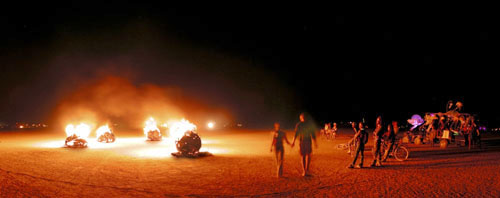




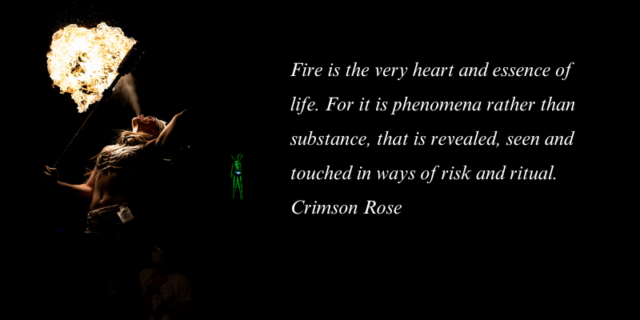
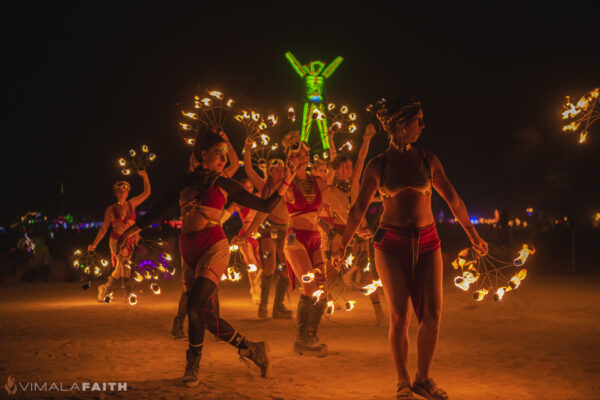

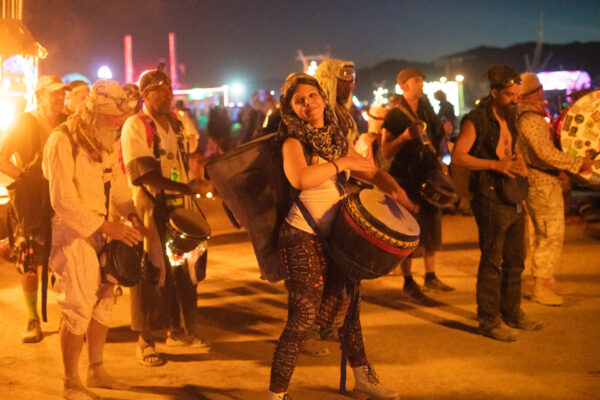
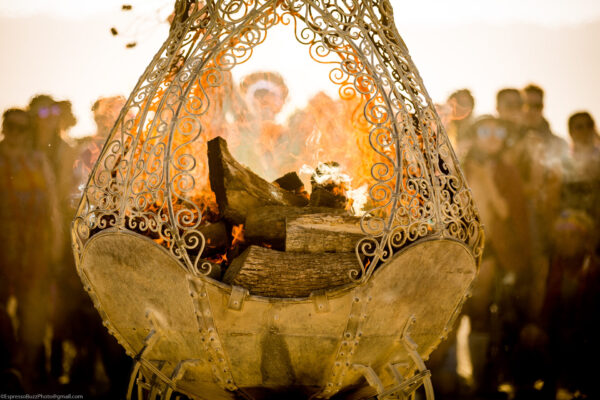
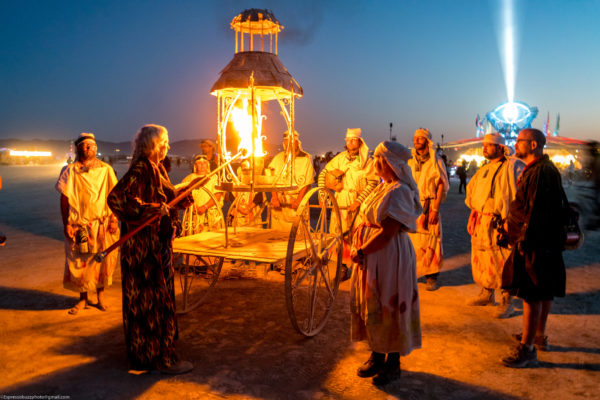
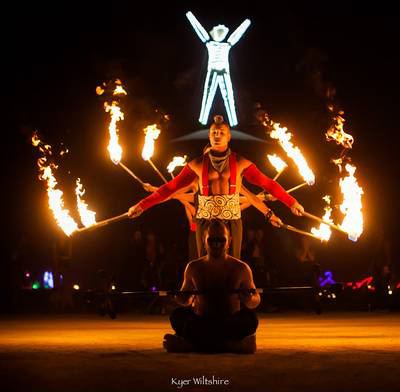 What was once a specialty dance created by a few has spread like wildfire. Fire Dancing has grown and matured into a full-blown performance art form, where the art is as varied as the imagination of those who dance with the flame. Fire Dance has its roots in many cultures and is embraced at Burning Man on a scale that is unmatched anywhere.
What was once a specialty dance created by a few has spread like wildfire. Fire Dancing has grown and matured into a full-blown performance art form, where the art is as varied as the imagination of those who dance with the flame. Fire Dance has its roots in many cultures and is embraced at Burning Man on a scale that is unmatched anywhere.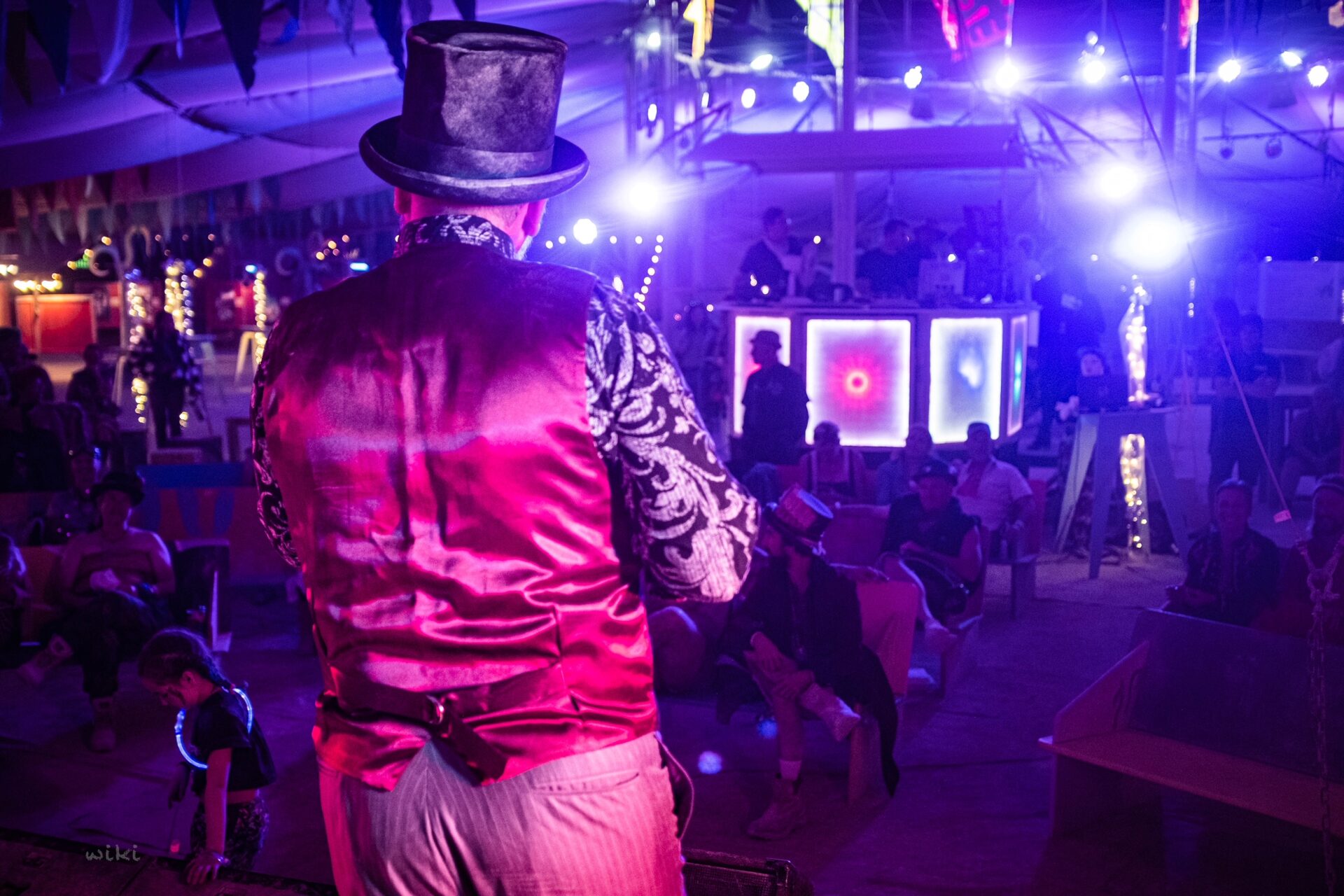
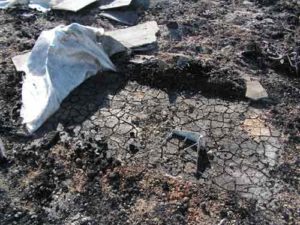
 Burning Man has learned that a 4-inch layer of Decomposed Granite (DG) placed between the surface of the playa and pre-construction of the artwork, like the example shown here, will provide an insulating layer protecting the playa from heat.
Burning Man has learned that a 4-inch layer of Decomposed Granite (DG) placed between the surface of the playa and pre-construction of the artwork, like the example shown here, will provide an insulating layer protecting the playa from heat.


